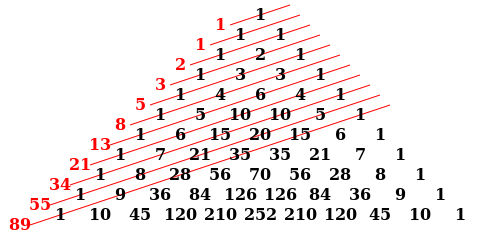We were discussing Leonardo of Pisa, Filius Bonacci, this week in class, and despite it being the least of his accomplishments, THE sequence always comes up. I finally wised up and, rather than fight it, separated out the sequence stuff into a day of its own.
Our Agenda:
- The original puzzle
- And Pascal, too?
- Spirals & Golden Ratio: what is going on?
- Vi Hart awesomeness: Part 1 of 3. WATCH at least part 1.
- Extensions
Puzzle
The puzzle appeared in Fibonacci's momentous The Book of Calculation. In addition to lots of fine mathematics, examples of calculation algorithms, and applications, it has entertaining puzzles and activities. One of these was deeper than he could know.
“A certain man put a pair of rabbits in a place surrounded on all sides by a wall. How many pairs of rabbits can be produced from that pair in a year if it is supposed that every month each pair begets a new pair which from the second month on becomes productive?”
The students were awesome with this. They knew the sequence already, of course, but did a nice job fitting the sequence to the situation. What impressed me were their objections. What if the rabbits weren't split males and females? What about mortality? What about that rabbits can be pregnant with to litters at once? (
Impressive. Turns out they can conceive the day they give birth, also impressive, and giving credence to LoP's 1 litter per month.) Also a student who tried to think about all possible pairs. Just good math thinking. The emphasis I tried to convey was making sense of the two representations: the tree diagram that helped most make sense, and the usual expression of the sequence summing two terms to get the next.
Pascal
I love that the sequence shows up in diagonals of the other mystical math favorite: Pascal's Triangle.I challenged the students with the more important question: why? They both have the add two to get one idea - is that related?
(This image from
mathispun.) Does anyone know ow to phrase a probability question that brings up this relationship?
Spiral
Ever since Susan Walborn and I did this with 5th graders for the
Math in Art festival (art connection: Mondrian) I have loved this. It so naturally ties in with the near similarity, and then the fabled Golden Ratio.

One of the things I love is how fast the sequence converges even if you don't start with a square. Start with a very non-square 1x10 and ... well, just look. You can play with
the spreadsheet on Google docs.
If you're talking Fibonacci Spirals, you have to watch
some Vi Hart. They were properly amused and impressed.
Lastly
Explore on your own, of course. Ideas:
explore one of the connections
look into closed form generation of the numbers
explore golden ration connections
-
Prove a Fibonacci Proposition
Extra:
-
-
-
-
-
-
-
-
How many ways to cover a 2xn grid with 1x2 dominoes?
There are an infinite number of Fibonacci numbers, and an infinite number of primes, but are there an infinite number of Fibonacci primes?
- How does the Fibonacci sequence extend backwards?
People tried more with the spiral, including on isometric dot paper. Some played with the sequence and ratios.
Some tried to prove the provided propostions: (senior math majors)
My extension
I was interested in the spiral, too. (
It's a
minor obsession.) One interesting thing is that it is an approximation of the Golden spiral (the logarithmic spiral built on
Φ), but it has a beginning. However the Fibonacci sequence extends backwards, ...8, 5, 3, 2, 1, 1, 0, 1, -1, 2... so what would that look like for the Fibonacci spiral?
I made a tool in GeoGebra for adding arcs and the center of the next arc for a spiral growing counter clockwise without too much trouble. But it was hard to find a way to do the backwards step that was robust. I wound up going with a vector approach instead of geometric, to better simulate those alternating terms going backwards. It made for some pretty interesting curves!
This gif is showing the same curve depending on the starting ratio of the first two steps. 1:1 to 2:1. Sometimes you get cycles - that's what those four petal flowers are: like 0, 2, 0, 2, ... If you want to play with it yourself, the tools are in this sketch on GeoGebraTube. (Sometimes tools don't work well in the student worksheet and you have to download the .ggb file.)
I also fooled around to make some art for myself. That's in a Tumblr post.










